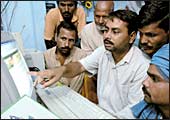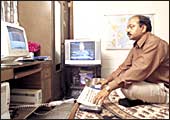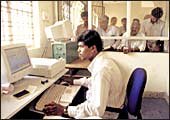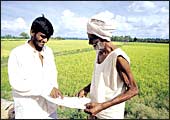|
The Wired Enterprise
Digital supply chain
 |
| Fieldwork: e-Choupals empower
rural consumers |
This is one happy trend. It has
rendered companies more efficient, enhanced the quality of their
products in most cases, reduced end-user costs in some and, finally,
enabled a legion of consultants to make money off it. It, of course,
is the digital supply chain. Definitions first: some people define
a supply chain as something that links a company's suppliers to
it; others prefer a larger definition and to them the supply chain
is something that links a company's suppliers, channel partners
(read: dealers), even customers with it. As is evident from both
definitions, all supply chains have two layers, an information
one, and a physical one, with the physical flow of goods usually
being in the opposite direction to the flow of information. The
net facilitates the real time flow of information and with cost
reduction being a popular theme across India Inc. all through
the 1990s, companies large and small have adopted digital supply
chains. And as ITC has shown with its e-choupals (there are 5,300
of them serving 3.2 million farmers), digital supply chains can
engender creative business models. What started as an effort to
provide real time information on the prices of agricultural commodities
to farmers and do away with intermediaries, has grown into a phenomenon
that facilitates the creation of an empowered and informed rural
marketplace, one that the company can tap as it chooses.
-E. Kumar Sharma
 |
| Numbers game: It is definitely
a bull market for online trading |
Click To Trade
Online trading
Actually, BT's listing of durable
dotcoms should give this away: there are three online brokerages
on it, Indiabulls, icicidirect, and the SSKI-promoted Sharekhan.
Each has had to hybridise the pure trading model, but the fact
remains that between them, the three boast some 800,000 customers
that prefer to do their trading online. "The market changes
every moment and price discovery is an ongoing process,"
says Jaideep Arora, Director, Sharekhan. "That is the key
reason for the success of online broking."
-Priya Srinivasan
Wired, That's Us
Intranets
 Knowledge
management systems, corporate policies, rules while entertaining
people, queries related to hr policies, bulletin boards, listing
of corporate events... phew! These, and just about anything else
that can be of some use to employees can today be found on intranets
(the internet, see, but it is a secured enclosure for the company
alone) of companies across the country. Some organisations have
gone a step forward and built intranets that span their vendors
and dealers. Auto major Maruti, for instance, has one that connects
215 vendors and 350 dealers with the company (that's the digital
supply chain bit all over again).Priya Srinivasan Knowledge
management systems, corporate policies, rules while entertaining
people, queries related to hr policies, bulletin boards, listing
of corporate events... phew! These, and just about anything else
that can be of some use to employees can today be found on intranets
(the internet, see, but it is a secured enclosure for the company
alone) of companies across the country. Some organisations have
gone a step forward and built intranets that span their vendors
and dealers. Auto major Maruti, for instance, has one that connects
215 vendors and 350 dealers with the company (that's the digital
supply chain bit all over again).Priya Srinivasan
 |
 |
| No paperwork: Karnataka's
Bhoomi project has consigned manual land registers to history |
Rule-based
e-governance
There is a simple reason why India
needs to go the e-governance way: despite a surfeit of laws and
regulations, most of the country's administrative entities govern
not on the basis of rules, but on the basis of exception; software
(or code) is rules-based; and by adopting e-governance systems,
governments across the country can become more efficient, less
corrupt, and maybe actually achieve some of the things they are
supposed to. Not surprisingly then, the states that have experimented
with e-governance projects have found the returns (in terms of
gains in efficiency and public acclaim) significant enough to
persist with them, even launch new ones. Karnataka's Bhoomi project
(computerisation of land records), initiated in 1999, went live
in 2001, and, according to the state's it secretary, M.K. Shankaralinge
Gowda, has "become self-sustaining and emerged a good revenue
model". That means the Rs 5 farmers pay for a copy of the
document is enough to meet all expenses associated with the project.
The state has done away with manual land registers (some 176 Bhoomi
kiosks serve the purpose). There are more success stories, such
as Andhra Pradesh's e-seva, an over-the-counter facility for the
payment of utility bills and 160 services of 12 government departments
(260 centres in all: 214 centres in 117 municipalities across
the state, and 46 in and around Hyderabad and Secunderabad). The
significant thing about both Bhoomi and e-seva is that they have
survived changes in government. Now, if e-governance can graduate
from a random trend to an endemic one.
-E. Kumar Sharma
My Space
Blogs
 It
would be this writer's educated guess that there are a few thousand
Indian blogs out there (that are maintained regularly; say, once
a week). Bloggers in India are yet to achieve the muscle they
have in the us-the 2004 Presidential election saw bloggers being
invited, along with their counterparts from traditional media,
for campaign events and Nick Denton, who runs several profitable
theme blogs, including Wonkette (politics), Gizmodo (technology)
and Fleshbot (pornography), was recently named among the most
powerful people in the us media by Media magazine-but the micro-publishing
revolution is here to stay. Well, if my editor junks this contribution,
guess where it is going up? It
would be this writer's educated guess that there are a few thousand
Indian blogs out there (that are maintained regularly; say, once
a week). Bloggers in India are yet to achieve the muscle they
have in the us-the 2004 Presidential election saw bloggers being
invited, along with their counterparts from traditional media,
for campaign events and Nick Denton, who runs several profitable
theme blogs, including Wonkette (politics), Gizmodo (technology)
and Fleshbot (pornography), was recently named among the most
powerful people in the us media by Media magazine-but the micro-publishing
revolution is here to stay. Well, if my editor junks this contribution,
guess where it is going up?
-Kushan Mitra
 |
| Net-working: Most Indians
access the net at cyber cafes |
Every-net
Cyber cafes
First, the numbers: India has more
than 200,000 cyber cafes; and more than 60 per cent of the country's
39 million net users access it from a cyber café. Most
representatives of the genre are one-pc Mom & Pop stores with
mere dial-up access. However, companies such as Sify and Reliance
Infocomm boast nationwide chains, at least 10-15 PCs per outlet,
and broadband access. In other parts of the world, cyber cafes
are just another point of access; in India, they are often the
only one and help bridge the digital divide. For the record, surfing
rates are now as low as Rs 10 an hour.
-Venkatesha Babu
Mobile Warriors
Teleworking
 No,
this isn't about people working on the move. Rather, it is about
the offshoring of services, something that the net (in one form)
made possible. It started with lowly medical transcription, but
has now taken on an entirely new meaning with business process
outsourcing of high-end services such as equity research, patent
filings, even legal work. And to think it all began with entrepreneurs
that could rustle up a few hundred employees who could speak English,
some computers, and adequate bandwidth. No,
this isn't about people working on the move. Rather, it is about
the offshoring of services, something that the net (in one form)
made possible. It started with lowly medical transcription, but
has now taken on an entirely new meaning with business process
outsourcing of high-end services such as equity research, patent
filings, even legal work. And to think it all began with entrepreneurs
that could rustle up a few hundred employees who could speak English,
some computers, and adequate bandwidth.
-Sahad P.V.
 Fat
Pipes Fat
Pipes
Broadband
It was only in January 2005, just
under 10 years after the beginning of the internet age, that true
broadband (read: speeds of 256 kbps and higher, and at a price
designed to increase usage) arrived in India. That was when state-owned
telcos, BSNL and MTNL, launched their services; private telcos
responded by slashing their own rates and between January and
June 2005, the number of broadband subscribers soared nine times,
from 50,000 to 450,000. With the Telecom Regulatory Authority
of India putting out figures to show that over 60 per cent of
new internet users in the April-June quarter signed up for broadband,
not dial-up access, the trend is well on its way to becoming a
phenomenon.
-Sahad P.V.
Ticket To Ride
Online ticketing and travel
 Proof
that travel and ticketing sites are at the vanguard of the Indian
internet revolution comes from a report put out by the Internet
and Online Association of India, a federation of internet companies,
that shows that online ticketing accounted for 63 per cent of
the Rs 570-crore worth of e-commerce transactions that India witnessed
in 2004-05. That's a cool Rs 370 crore. With India's growing slew
of low-cost airlines hawking tickets online, this segment will
continue to drive e-commerce in the country, which is expected
to touch Rs 2,300 crore in 2006-07. Proof
that travel and ticketing sites are at the vanguard of the Indian
internet revolution comes from a report put out by the Internet
and Online Association of India, a federation of internet companies,
that shows that online ticketing accounted for 63 per cent of
the Rs 570-crore worth of e-commerce transactions that India witnessed
in 2004-05. That's a cool Rs 370 crore. With India's growing slew
of low-cost airlines hawking tickets online, this segment will
continue to drive e-commerce in the country, which is expected
to touch Rs 2,300 crore in 2006-07.
-Sahad P.V.
 Killer
App Killer
App
e-mail
To those born in the 1990s, even
to those who got acquainted with the killer app in that decade,
it is difficult to visualise life without e-mail. Today, barring
Luddites and technophobes, everyone has an e-mail account and
bulk of the traffic that traverses the net is believed to be e-mail.
Strangely enough, if e-mail was the killer app of the 1990s, anti-spam
technology may turn out to be that for this decade.
-Venkatesha Babu
Five That Failed
Cricket Sites
Despite India being cricket country and Indians being cricket-crazy,
not too many cricket sites have done well (the exceptions are
cricinfo.com and cricketnext.com). Why? Perhaps for the same reason
sports magazines haven't done well in India. For the record, the
Board of Control for Cricket in India (BCCI) does not have an
official website
Communities
This magazine has partnered, on occasion, with coolavenues.com,
a community site for MBAs (PGDBMs included) that continues to
tread the middle ground between surviving and thriving. Yet, most
other attempts at building communities around vocations or anything
else in India have failed. Then, similar attempts in the West
have failed too.
Real Estate Portals
Another domain that witnessed an influx of get-rich-quick entrepreneurs
offering everything from 360-degree virtual interfaces to easy
financing options. Apart from a rare indiaproperties.com that
continues to thrive, the others have largely gone belly up or
remain pale imitations of the classified sections of newspapers.
B2C Commerce
The horizontals (think Indiainfo.com, Indya.com, 123India.com)
wanted to sell everything from books to holidays. Easybuymusic
wanted to sell digital music downloads; Jaldi wanted to aggregate
demand and offer consumers hefty discounts;... surely, you get
the picture? None worked. Then, Webvan didn't either in the US.
B2B Exchanges
For eight months, between April and December 2000, B2B exchanges
held forth the promise of being the next big thing. Today, exchanges
such as Essar's Clickforsteel, Tata and SAIL's MetalJunction,
and Jindal's eSteelmart are simple auction sites, not exchanges.
"There is no price discovery that happens on these portals;
it is just vanilla auctions that take place, not even reverse
auctions," says an executive at a steel portal.
|






 Knowledge
management systems, corporate policies, rules while entertaining
people, queries related to hr policies, bulletin boards, listing
of corporate events... phew! These, and just about anything else
that can be of some use to employees can today be found on intranets
(the internet, see, but it is a secured enclosure for the company
alone) of companies across the country. Some organisations have
gone a step forward and built intranets that span their vendors
and dealers. Auto major Maruti, for instance, has one that connects
215 vendors and 350 dealers with the company (that's the digital
supply chain bit all over again).Priya Srinivasan
Knowledge
management systems, corporate policies, rules while entertaining
people, queries related to hr policies, bulletin boards, listing
of corporate events... phew! These, and just about anything else
that can be of some use to employees can today be found on intranets
(the internet, see, but it is a secured enclosure for the company
alone) of companies across the country. Some organisations have
gone a step forward and built intranets that span their vendors
and dealers. Auto major Maruti, for instance, has one that connects
215 vendors and 350 dealers with the company (that's the digital
supply chain bit all over again).Priya Srinivasan

 It
would be this writer's educated guess that there are a few thousand
Indian blogs out there (that are maintained regularly; say, once
a week). Bloggers in India are yet to achieve the muscle they
have in the us-the 2004 Presidential election saw bloggers being
invited, along with their counterparts from traditional media,
for campaign events and Nick Denton, who runs several profitable
theme blogs, including Wonkette (politics), Gizmodo (technology)
and Fleshbot (pornography), was recently named among the most
powerful people in the us media by Media magazine-but the micro-publishing
revolution is here to stay. Well, if my editor junks this contribution,
guess where it is going up?
It
would be this writer's educated guess that there are a few thousand
Indian blogs out there (that are maintained regularly; say, once
a week). Bloggers in India are yet to achieve the muscle they
have in the us-the 2004 Presidential election saw bloggers being
invited, along with their counterparts from traditional media,
for campaign events and Nick Denton, who runs several profitable
theme blogs, including Wonkette (politics), Gizmodo (technology)
and Fleshbot (pornography), was recently named among the most
powerful people in the us media by Media magazine-but the micro-publishing
revolution is here to stay. Well, if my editor junks this contribution,
guess where it is going up?
 No,
this isn't about people working on the move. Rather, it is about
the offshoring of services, something that the net (in one form)
made possible. It started with lowly medical transcription, but
has now taken on an entirely new meaning with business process
outsourcing of high-end services such as equity research, patent
filings, even legal work. And to think it all began with entrepreneurs
that could rustle up a few hundred employees who could speak English,
some computers, and adequate bandwidth.
No,
this isn't about people working on the move. Rather, it is about
the offshoring of services, something that the net (in one form)
made possible. It started with lowly medical transcription, but
has now taken on an entirely new meaning with business process
outsourcing of high-end services such as equity research, patent
filings, even legal work. And to think it all began with entrepreneurs
that could rustle up a few hundred employees who could speak English,
some computers, and adequate bandwidth. Fat
Pipes
Fat
Pipes Proof
that travel and ticketing sites are at the vanguard of the Indian
internet revolution comes from a report put out by the Internet
and Online Association of India, a federation of internet companies,
that shows that online ticketing accounted for 63 per cent of
the Rs 570-crore worth of e-commerce transactions that India witnessed
in 2004-05. That's a cool Rs 370 crore. With India's growing slew
of low-cost airlines hawking tickets online, this segment will
continue to drive e-commerce in the country, which is expected
to touch Rs 2,300 crore in 2006-07.
Proof
that travel and ticketing sites are at the vanguard of the Indian
internet revolution comes from a report put out by the Internet
and Online Association of India, a federation of internet companies,
that shows that online ticketing accounted for 63 per cent of
the Rs 570-crore worth of e-commerce transactions that India witnessed
in 2004-05. That's a cool Rs 370 crore. With India's growing slew
of low-cost airlines hawking tickets online, this segment will
continue to drive e-commerce in the country, which is expected
to touch Rs 2,300 crore in 2006-07. Killer
App
Killer
App